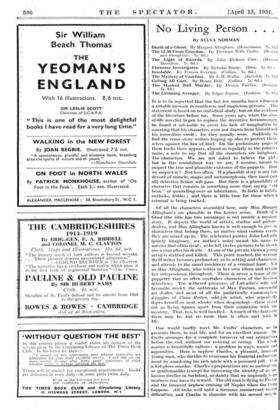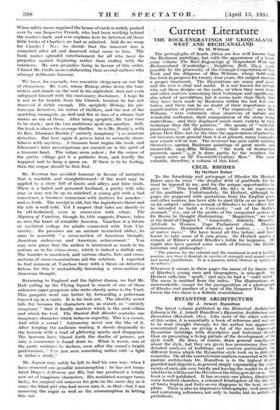No Living Person . • •
By SYLVA NORMAN
The Grinning Avenger. By Edgar Jepson. (Jenkins. 75. 6d.) IT is to be regretted that-the last few months have witnessed a notable increase in murderers and suspicious persons. This statement is basedon no statistical study, but on the evidence of the literature before me. Some years ago, when the slice- of-life novelist began to replace the inventive fictionmonger, he found it advisable to cover his lack of imagination by asserting that his characters were not drawn from himself and his immediate eireld ; for they usually were. Suddenly we find the crime-story writers leaping up also to protect them- selves against the flaw of libel. On the preliminary pages of these books there appears, almost as regularly as the printer's name, a note to say that all the characters are imaginary. The characters. We are not asked to _believe the plot; but in this roundabout way we are, I assume, meant to suspect the true and plausible existence of the puppets. Dare we suspect it ? Not too often. If a plausible story is any tale devoid of miracle, magic and metamorphosis, then most (not all) detective fiction will pass. But there is a plausibility of character that consists in something more than saying "old bean" or quarrelling over an inheritance. It lurks in habits, ! outlooks, foibles ; and there is little time for these when a criminal is being tracked.
Of all the characters assembled here, only Miss Margery Allingham's are plausible in this keener sense. Death of a Ghost (the title has two meanings) is not merely a mystery story. It depicts the world of artists, studios and picture- dealers, and Miss Allingham knows it well enough to give us characters that belong there, no matter what curious events they are mixed up in. The celebrated painter John Lafeadio (purely imaginary, see author's note) meant his name to survive that of his rival ; so he left twelve pictures to be shown one a year after his death: At one of the private views a young artist is stabbed and. killed. This point reached, the average thrill-writer becomes perfunctory as to setting and characters, and attends to the usual machinery of a criminal hunt. Not so Miss Allingliam, who writes in her own idiom end retains her independence throughout. There is never a trace of the puppetry that -so often overtakes characters of the liveliest intentions. The sylthered presences of Lafeadio's wife and favourite model, the outbreaks of Max Fustian, successful
art dealer; -and most of all the pathetically commonplace struggles of Claire Potter, odd-job artist, who repeatedly dopes herself on neat _whisky, when despondent—these stand out as living figures apart from their connexion with the mystery. That, too, is well handled. A touch of the fantastic
there may be, but no- more than is often met with in
life. .
One would hardly- meet Mr. Crofts' characters, as he
presents them, in real life, and for an excellent reason. Mr. Croftsarranged for 'd -complete turnover of-our sympathies before the end, without our noticing or caring. The whole Matter is beautifully callous : a problem in ways, means and ingenuities. Here is nephew Charles, a pleasant,
innocent
young man, who decides to overcome his financial embarrass- Ment by murdering his rich uncle with a poisoned pill. It is a kid-glove murder. Charles's preparations are so meticulous) so gentlemanlike (except for borrowing the identity of an un- known dweller in Surbiton), so.dainty that.weimpiously hope neatness may have its reward. The old man is flying to France and the innocent nephew cruising off Naples when the thing happens. All looks well until a tiresome manservant makes difficulties, and Charles is clumsier with his second corpse. When safety seems regained the house of cards is rudely pushed over by one Inspector French, who had beeff'svneklitg- behind the reader's back, and now explains how he detectedall those little tricks of Charles's we had so admired. Anil do we weep for Charles ? No; we decide that the innocent Was scoundrel after all and deserved what came to him. The book makes splendid entertainment for all who have no prejudice against beginning rather than ending 'with the murderer. My own prejudice being in favour of-this order, I found Mr. Crofts more exhilarating than several authors who attempt deliberate humour.
We have, for example, two eccentric clergymen on our list of characters. Mr. Carr, whose Bishop slides down the ban- nisters and stands on the roof in his nightshirt,- does. not even safeguard himself with the customary disclaimer. I hope he is not in for trouble from the Church, because he his net deserved it richly enough. His sprightly Bishop, his pic- turesque detective, his writer of thrillers, and the rest of the sparkling menagerie, go dull and flat in face of a climax that makes no use of them. After being sprightly, Mr. Carr tries to be stark ; and the two ambitions spoil one another. Still, the book is above the average thriller. So is Mr. Brady's, with its Rev. Ebenezer Buckle (" entirely imaginary "). as amateur detective. But here again it proves hard to reconcile cheer- fulness with mystery. A treasure hunt begins the book, and Ebenezer's later investigations are carried on in the spirit of a treasure hunt. The values seem askew ; for the corpse of the pretty village girl is a pathetic item, and hardly the happiest nail to hang a game on. If there is to be fooling, then the corpse should be first fool.
Mr. Everton has avoided humour in favour of narrative that is readable and straightforward—if the word may be applied to n story full of knots and alleys and false trails. There is a • hated and poisoned husband, a pretty wife who may or may not be up to mischief, a young girl with a bad conscience, a business connexion with motives for murder— and so forth. The receipt is old, but the ingredients blend and the talc is well told. Yet I suspect that tales are shortly to be old-fashioned, even in connexion with crime. The Mystery of l'aucluse, though its title suggests France, takes us into the heart of scientific America. Vaucluse is a future or mythical college for adults connected with Yale Uni- versity. Its premises are an ancient re-erected abbey, its aims to assemble a cross-section of American thought, American endeavour and American achievement." You may now guess that the author is interested as much in his notions as in his crime-story, which is indeed a dullish one. The founder is murdered, and various charts, lists and cross- sections of cross-examinations aid the solution. I expected to find someone at Vaucluse busy with a thesis on detective fiction, for this is undoubtedly becoming. a cross-section of American thought. .
Returning to England and the lighter drama, we find Mr. Holt calling up the Flying Squad in search of one of those unknown super-gangsters who write cheeky notes to the Yard. This gangster went one better by forwarding a policeman trussed up in a crate. It is his best act. The identity secret falls flat because the characters are, as stated, so "entirely imaginary " that it hardly matters which is the arch-villain and which his tool. The Masked Ball Murder contains one imaginary character which behaves superbly. This is a comet. And what a comet Astronomy never saw the like of it. After keeping the audience waiting, it shoots diagonally to the horizon with a trail of glittering sparks and disappears. The heavens have blazed- forth_ the, deaths of princes, yet only a commoner is found done in. What is worse, one of the party ventures to declare, soon after the comet's bright performance, " rVe just seen something rather odd—a light in father's study."
Mr. Jepson may safely 'be left to find his own way, when I have removed one possible misconception : he has not trans- lated Hugo's L'Homme -4ui Bit, but has produced a totally new set of imaginary characters. His mutilated avenger turns lucky, for surgical aid removes his grin on the same day as it cures -the blind girl who had never seen it, so that—but I am . removing the sugar as well as the misconception in -letting -this out.

















































 Previous page
Previous page